If you are spending a day or two in the Andalusian city of Cordoba you simply cannot miss the Jewish quarter, known locally as La Judería. It’s winding streets and tapas tavernas will greet you and the history there will have you hooked. La Judería was declared a world heritage site in 1994. If you have a limited amount of time in Cordoba do not worry – you can see this area in as little as just half an hour. Don’t miss the Maimoinedes statue and the 14th Century Synagogue.
How to get to the Jewish Quarter Cordoba (La Judería)
The Jewish quarter in Cordoba is easy to find from the Mezquita (the famous Mosque-Cathedral which can be used as a point of navigation in Cordoba). From the North East corner of the Mezquita, head down Calle Juderia and you know that you are on the right path to the Jewish quarter. Here is a map highlighting how to get there and the main sites of La Judería.
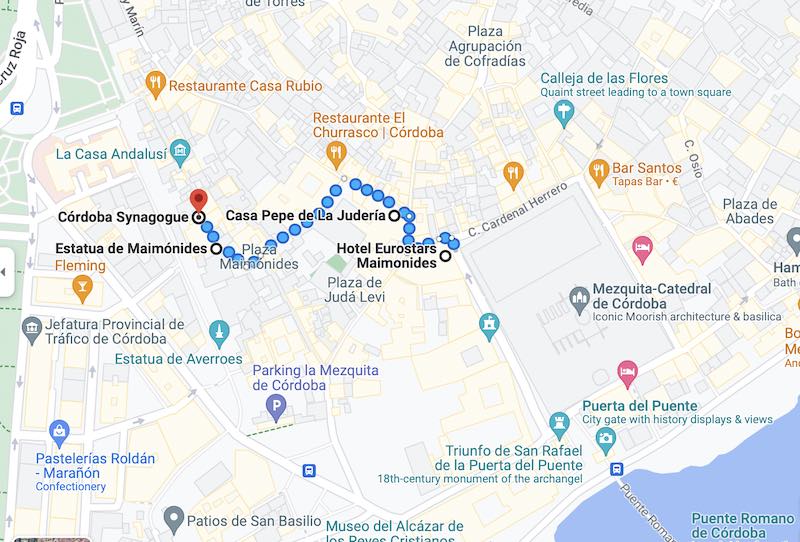
History of the Jewish Quarter in Cordoba
The Jewish Quarter in Cordoba, also known as the Juderia, has a rich and complex history dating back to the Roman period. The Jews have a long history in Spain, dating back to the Visigothic period (6th-8th centuries), and they were particularly prominent in Cordoba during the Islamic period (8th-15th centuries).
During the Islamic period, Cordoba was a center of learning and culture, and the Jewish community played an important role in the city’s intellectual and commercial life. The Jewish Quarter was located in the heart of the city, near the Great Mosque (now known as the Mezquita-Catedral de Córdoba), and was home to a number of synagogues, shops, and homes.
However, in 1391, anti-Semitic riots swept across Spain, and the Jewish Quarter in Cordoba was not spared. Many Jews were killed or forced to convert to Christianity, and their homes and synagogues were destroyed. Despite this, the Jewish community in Cordoba continued to exist, although it was greatly diminished in size.
In 1492, King Ferdinand and Queen Isabella of Spain issued the Edict of Granada, which expelled the Jews from the country. Many Jews left Spain, including those in Cordoba, and the Jewish Quarter was left mostly abandoned.
The Main Sites of the Jewish Quarter Cordoba
Today, the Jewish Quarter in Cordoba is a popular tourist destination, known for its narrow streets, whitewashed houses, and historic synagogues. Some of the most notable buildings in the Jewish Quarter include the Synagogue of Cordoba, which dates back to the 14th century, and the Casa de Sefarad, a museum dedicated to Sephardic Jewish culture. Here are the most important things to visit…
Calleja de las Flores (Street of Flowers)
Possibly one of the most visited streets in Cordoba is Calleja de las Flores, or the street of flowers. It is famous for its beautiful flowers on the sides of the buildings and the patios. If you love this kind of thing then you might like to consider visiting Cordoba in May when they have their annual ‘Patio festival’.
Statue of Maimodides
There is a statue of the great Jewish philosopher Maimonides in Cordoba in the Jewish Quarter of the city. The statue was created by the Israeli sculptor Yaacov Agam and was unveiled in 1964 to commemorate the 800th anniversary of Maimonides’ death.
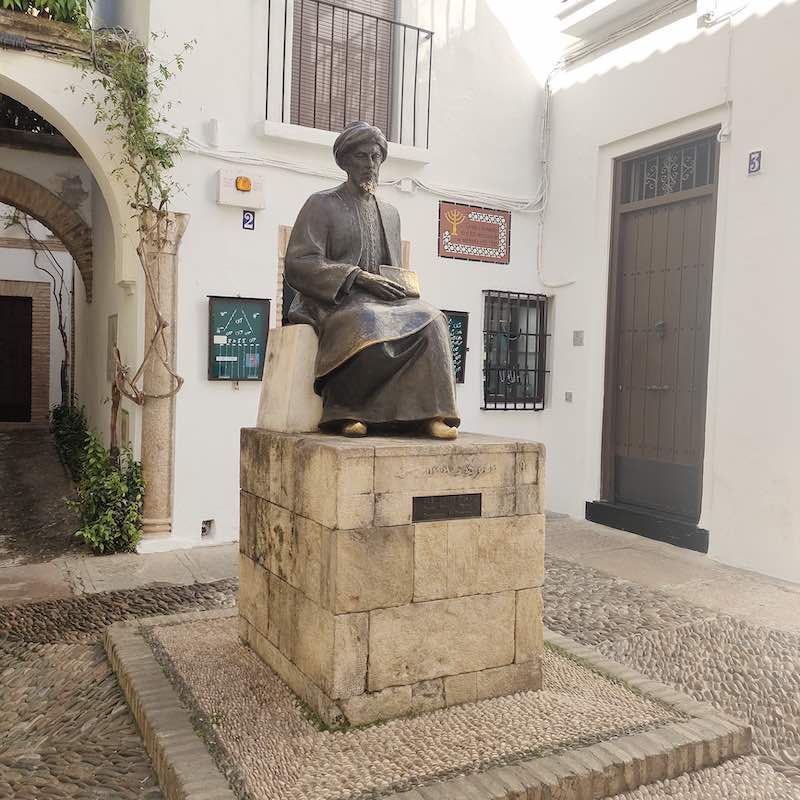
The statue shows Maimonides seated on a throne with a book in his hand, representing his scholarship and intellectual contributions. The inscription on the statue reads “From Cordoba to the world,” highlighting Maimonides’ impact on Jewish thought and his influence beyond his hometown. There is a sign on the wall commemorating the 850th year since his birth.
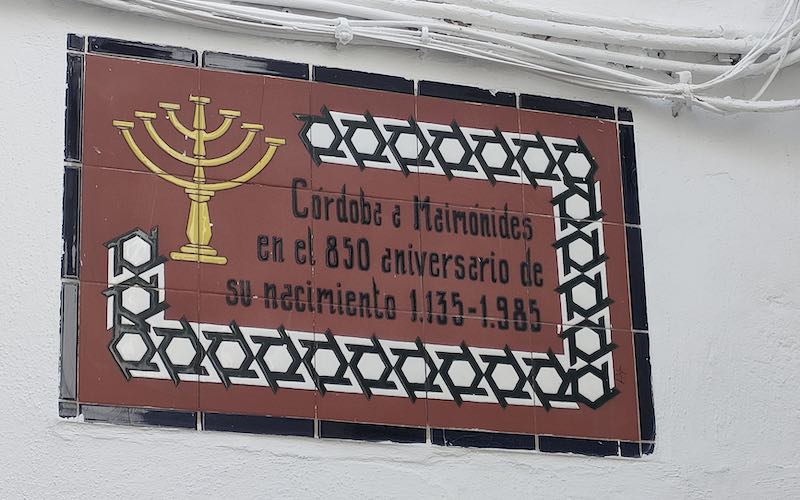
Who was Maimonides?
Moses ben Maimon, also known as Maimonides, was a Jewish scholar, philosopher, and physician who lived in Spain and Egypt during the 12th century. He is considered one of the most important figures in Jewish intellectual history.
Maimonides was born in Cordoba, Spain in 1135, during the Islamic period when Cordoba was a center of learning and culture. When he was young, his family was forced to flee Spain due to the persecution of Jews, and they eventually settled in Fostat, Egypt.
Maimonides was a prolific writer and produced works on a wide range of topics, including Jewish law, philosophy, medicine, and theology. His most famous works include the Mishneh Torah, a comprehensive code of Jewish law, and the Guide for the Perplexed, a philosophical treatise on the nature of God and the relationship between reason and faith.
Maimonides’ scholarship and writings had a profound influence on Jewish intellectual history and beyond. He was also an important physician and served as the personal physician to the Sultan of Egypt. Maimonides died in Egypt in 1204, but his legacy continues to be felt in Jewish thought and scholarship to this day.
Plaza Maimonides (Maimonides Square)
One of the most beautiful squares in La Juderia is Maimonides square – a square named after the great scholar himself.
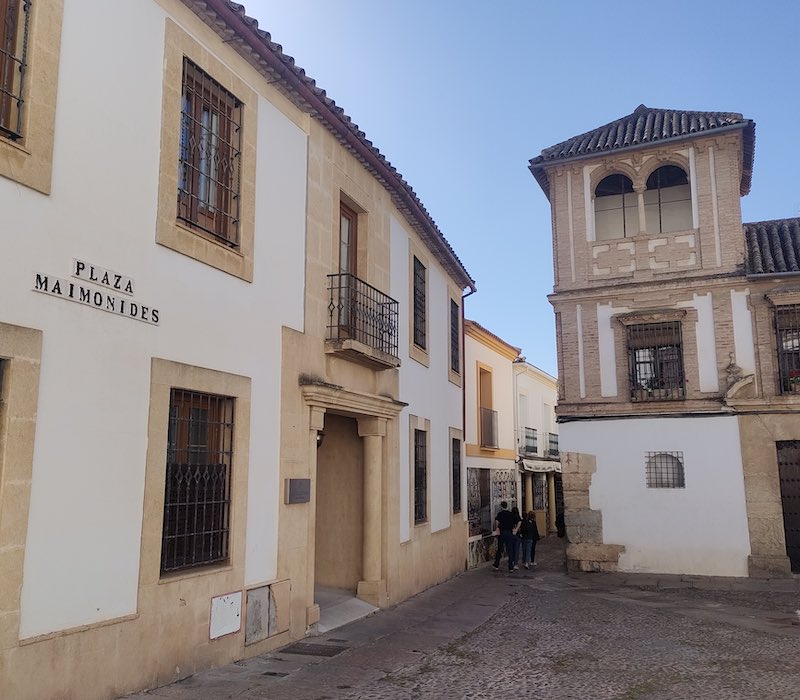
On this square you will also find the museum of Bull Fighting which occupies a former 16th century aristocratic mansion. It’s not my cup of tea – I am against bullfighting as a blood sport and cried all the way through the bull fight that I once attended in attempt to ‘absorb Spanish culture’. However, I understand that it is part of the history and culture of Spain and so if you want to find out more about this then you may find this museum interesting. The museum contains suits and equipment of Matadors (bull fighters) from the past.
14th Century Synagogue of the Jewish Quarter Cordoba
One of the best things about the Jewish Quarter in my opinion is the tucked away 14th Century Synagogue which was built in 1305 during the Moorish period and before the expulsion of the Jews from Spain. It’s free to get in and one of my favourite things to see in Cordoba. It consists of three sections – a courtyard, an outer section (with an upper women gallery) and the main Synagogue and mens gallery.
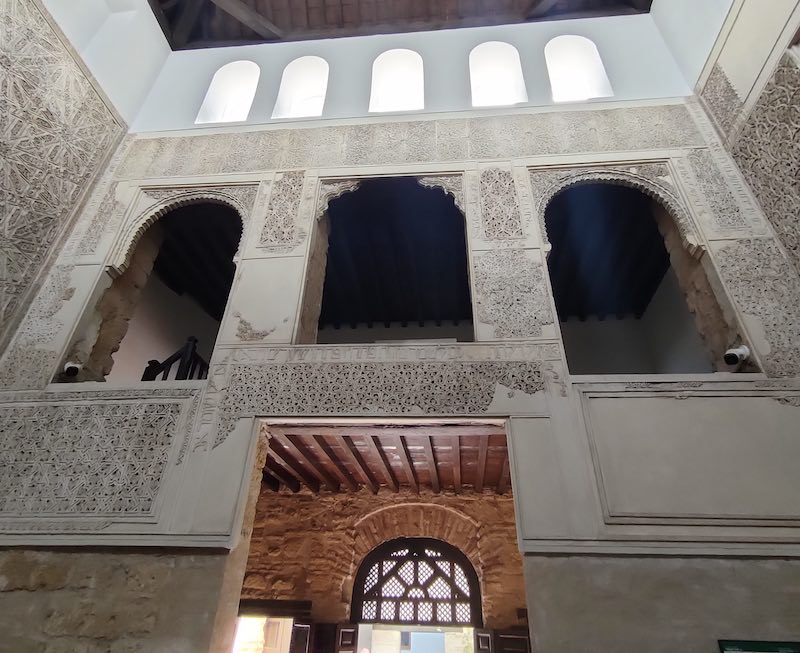
The inside walls of the main room in the Synagogue combine beautiful Moorish architecture including a Multifoil arch and extensive Hebrew inscriptions. The Hebrew writing that has not eroded has been translated and contains many Old Testament writings such as extracts from the book of Psalms.
Casa de Safarad – Museum of Jewish Heritage
The Casa de Sefarad is a museum and cultural centre found in the Jewish Quarter of Cordoba. It is dedicated to the history and culture of Sephardic Jews, who were a prominent community in Spain before their expulsion in 1492.
The building that houses the museum is a historic home that has been restored and adapted for its current use. Visitors to the museum can explore the various rooms of the house, which contain exhibits on Sephardic Jewish culture, history, and traditions.
The museum’s collection includes artifacts such as religious objects, textiles, and manuscripts, as well as interactive exhibits and audiovisual presentations. The museum also hosts cultural events, such as concerts and lectures, aimed at promoting Sephardic Jewish culture and heritage. Casa de Sefarad also serves as a research center for the study of Sephardic Jewish history and culture. The museum offers guided tours in several languages.
La Casa Andalusi
La Casa Andalusi is a museum dedicated to showcasing the culture and heritage of the region of Andalusia. It is housed in a restored 12th-century building that was originally a palace built by the Muslim ruler, Al-Mu’tamid. The building was later used by the Catholic monarchs, Ferdinand and Isabella, during their reign in the late 15th century.
Visitors to La Casa Andalusi can explore the various rooms of the palace, which are decorated with intricate tile work, carvings, and other decorative elements that reflect the artistic and architectural styles of the Muslim and Christian periods of Cordoba’s history.
The museum’s exhibits include artifacts and displays related to Andalusian culture, such as Islamic calligraphy, textiles, ceramics, and traditional musical instruments. Visitors can also learn about Andalusian cuisine and the region’s traditional agricultural practices.
Almodovar Gate
Slightly further North and on the outskirts of the city you will find Almodovar gate (Puerta de Almodovar in Spanish), which is so called because it was the route out of the city to Villa de Almodovar. It is one of the twelve gates that once provided access to the city during the Islamic period and is one of the few that remain standing to this day. The gate was originally built in the 8th century during the Islamic period and was used as a defensive fortification to protect the city from attack.
Almodovar Gate has undergone several renovations and restorations over the years, with the current structure dating back to the 14th century. It features an arched entrance with a horseshoe-shaped arch, which is typical of Islamic architecture, and is decorated with intricate carvings and tile work.
Where to eat in the Jewish Quarter Cordoba
After all that exploring, you must be hungry! Thankfully, this historic neighborhood is filled with charming streets and alleys lined with restaurants, cafes, and bars. Here are some popular options for dining in the area:
- Casa Mazal – This kosher restaurant serves traditional Jewish and Mediterranean cuisine, including falafel, hummus, and shakshuka. It also offers a variety of vegetarian and vegan options.
- Restaurante El Churrasco – El Churrasco is known for its delicious grilled meats, including beef, lamb, and pork. It also serves a variety of seafood dishes and has a selection of Spanish and international wines. Book in advance especially on weekends as it can get busy.
- La Boca – This restaurant offers a mix of Spanish and Mediterranean cuisine, with a focus on seafood and fresh, locally sourced ingredients. It has a cozy interior and a charming courtyard for outdoor dining.
- Taberna San Miguel – This traditional tapas bar is a popular spot for locals and visitors alike. It serves a variety of classic Spanish tapas, including fried fish, meatballs, and potato tortilla.
- Bodega Guzman – This family-owned tavern has been serving traditional Cordoban cuisine for over a century. It is known for its hearty stews, grilled meats, and delicious local wines.
- Bodegas Mezquita – A fantastic option for quality tapas near the Mezquita – the papayas bravos are quite spicy! Also a good option to try the traditional dishes of Rabo do Toro (Oxtail) or Flamenquin.
- Taberna El Capricho – A beautiful flower covered exterior, this little tapas restaurant is cheaper and better value than Bodegas Mezquita. Although it’s not so upmarket it is more traditional than touristy. Try the chorizo in red wine – delicious.
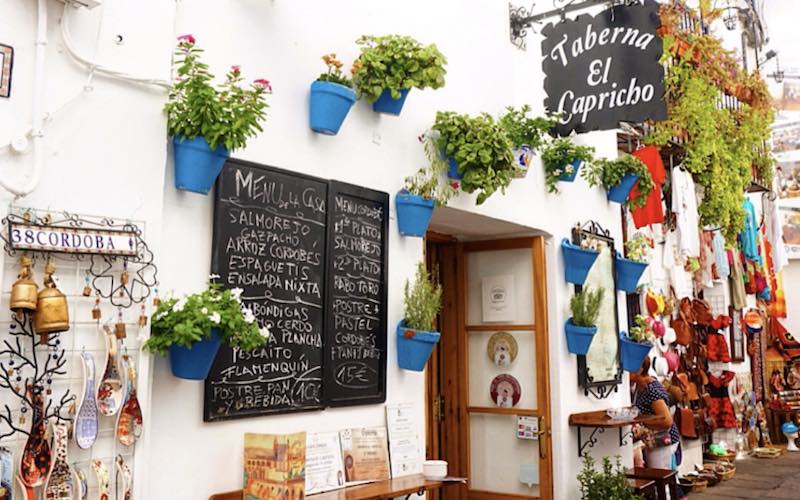
And finally, one thing is for sure – do not leave Cordoba until you have seen the famous Mosque-Cathedral ‘Mezquita’. This is one of the most stunning examples of Moorish architecture in Spain and is a beautiful combination of a Moorish and Christian interior.
Further Reading on Cordoba
If you are interested in finding out more about the 14th Century Synagogue of Cordoba click here.
You might also find this article helpful on how to spend one day in Cordoba.
I also recommend that you don’t miss Madinat Al Zahra, the abandoned ancient Moorish city.
More on Spain
Are you obsessed with Spain, just like me?! Head over to the following articles for Spanish travel inspiration…
- 9 amazing Churches in Barcelona
- Taking a Girona day trip from Barcelona
- The Phenomenal Sant Pau Hospital of Barcelona
- Santa Cruz Jewish Quarter Seville
